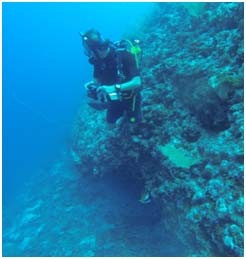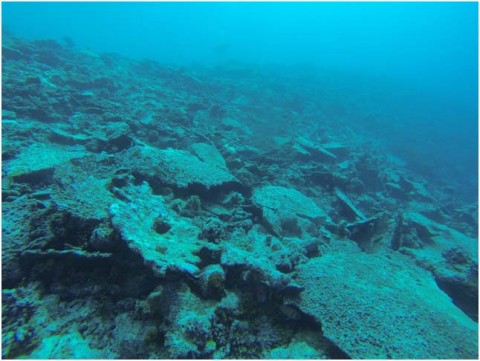BIOT Science Expedition 2014 - Dr Ronan Roche BIOT Science Expedition 2014 Initial Report
Understanding Coral Reef Structure
Dr. Ronan Roche, Bangor University
During the Darwin Initiative March/April 2014 expedition I built on the work carried out during the February/March 2013 expedition to examine reef structure to provide data that complement video transect surveys.
Reef structure data collected followed the protocol developed during 2013, in which the following variables were collected at 5-meter depth intervals during the dive:
- reef slope
- abundance of Acropora sp.
- proportion of Acropora sp. which are recently dead
- broad scale reef rugosity
- coral colony scale rugosity
Slope data provide information on the context of video coral reef surveys, to allow correct interpretation of the video footage obtained on the expedition. Acropora species are one of the most abundant branching species on many of the reefs around the Chagos archipelago, and provide a refuge for numerous species of reef fish. The proportion of dead Acropora corals can be used as an indication of reef health, and provides a complementary visual assessment to video surveys. This variable may also provide information on impacts such as storm damage to reefs, crown-of-thorns starfish feeding on branching corals, coral disease, or coral bleaching events.

Figure 4: Ronan Roche surveying reef rugosity, here encountering a cave on the reef slope at Egmont atoll
Rugosity assessments are important as reefs with higher rugosity provide a greater range of habitats, particularly for reef fish and generally exhibit higher biodiversity. Broad scale rugosity is an indication of the degree to which the reef surface undulates and has a topography that includes features such as caves or a spur and groove system. Colony scale rugosity is the degree to which the corals at a site are fully developed and contribute complexity to the reef structure.
Twenty-four sites were surveyed utilising this methodology during the March/April 2014 expedition, with contemporaneous underwater video survey. The Chagos archipelago contains sites which range from those with extremely complex reefs with high levels of rugosity, to those which are currently less developed and have minimal levels of rugosity. These differences primarily relate to the position of sites inside or outside of atoll lagoons, and to the degree of exposure to strong currents and wave impacts, whilst remaining differences are likely the result of storm impacts and biological impacts such as bleaching and disease. Initial examination of the data collected from the 2014 expedition indicates that many sites are being impacted by large dead Acropora colonies with ‘table’ morphology moving down reef slopes during storm events.

Figure 5: Dead Acropora tables at Egmont atoll

